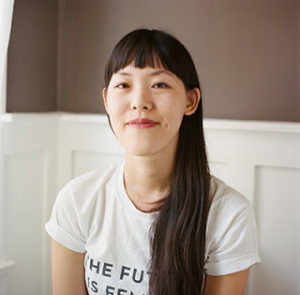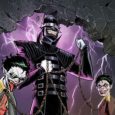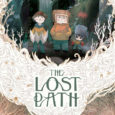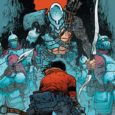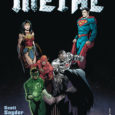Jen Wang is a cartoonist, author and illustrator from Los Angeles and is the creator behind Koko Be Good and co-author of the New York Times Bestselling graphic novel In Real Life with Cory Doctorow. Her latest book, The Prince and the Dressmaker, hit shelves on February 13th, 2018.
The Prince and the Dressmaker revolves around Prince Sebastian as he searches for a bride―or rather, his parents are strong arming him into finding one. However, Sebastian has a secret life: at night he puts on daring dresses and takes Paris by storm as the fabulous Lady Crystallia―the hottest fashion icon in the world capital of fashion!
Sebastian’s secret weapon (and best friend) is the brilliant dressmaker Frances―one of only two people who know the truth: sometimes this boy wears dresses. But Frances dreams of greatness, and being someone’s secret weapon means she has to stay a secret forever. It’s a romantic tale of identity, young love, art, and family.
We met up with Jen after a book signing at Emerald City Comic Con in Seattle.
LC: I wanted to talk a little bit about your protagonist and why you chose to make him exist outside of the heteronormative, cookie cutter, sort of hero. What was your reason for making him fluid?
JW: I think I just felt like…for a while I was looking for a story that would be like a positive Disney movie romantic comedy. Then I wanted to make sure it was a little more contemporary that felt a little queer. I had the idea of a character that would have this clear passion that people could relate to, even if they didn’t have a gender variant identity themselves. If you understand that Sebastian is into fashion and big dresses, that could be something anyone could relate to.
LC: You both wrote and illustrated the book, correct?
JW: Yes!
LC: Was it a conscious decision to make Sebastian unconventionally handsome compared to romcom heartthrobs?
JW: Yeah! I mean, the character is a teenager and I wanted him to look like a teenager. I didn’t want him to be super handsome or too adult looking or too sexy. Not that a teenager can’t be sexy, haha. I wanted to show the version of yourself when you’re still trying to figure out who you are. There’s a lot of recognition in a character who looks like someone you can relate to. I feel like most people seem themselves as conventional looking. The only thing I wanted to make sure to do was to give Sebastian a prominent facial feature . There’s so many costume changes; I didn’t want people to lose the character in a room full of ballgowns.
LC: How did you choose the time period for the book?
JW: The book takes place in the late 19th century and I wanted a time frame that would be sort of old-timey with people in corsets and horse drawn carriages. At the same time, I wanted there to be an emergence of technology. The 19th century had both of those things for me.
LC: Did you pull from any fashion designers as inspiration for your costume designs?
JW: I did research on clothing from the time period. I looked at a lot of historical cosplay costumers online, particularly accessories. There’s a ton of resources for that. The rest I tried to make a bit more modern like something people would wear now.
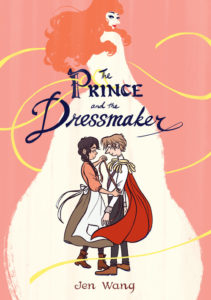 LC: Was it important for you to make the story accessible in every way, versus something that was more queer or adult?
LC: Was it important for you to make the story accessible in every way, versus something that was more queer or adult?
JW: You know, I wanted to make a book that I could read at 13 or 14. It was always the intention, I think. I didn’t really know that much at that age other than what cartoons I liked and what fantasy books I loved.
LC: When you were a teenager, were there any properties that felt accessible to you?
JW: I was really into anime and manga, which I discovered in middle school and high school. I had a friend who was Japanese who had a lot of that stuff. That was before you could find it at the library or in bookstores, haha. It’s actually how I got into comics in general. The thing that was the most influential to me was Revolutionary Girl Utena. I think you can see some overlapping themes in my stuff. It was the first thing I ever read that was queer and unabashedly feminine. I’d never read comics like that before. That was very influential to me.
LC: As someone who also got into comics through manga, I don’t think there was anywhere near the representation you see in that medium as far as the genres of stories you could experience.
JW: There was so much more aimed at teenage girls! I felt completely ignored by American publishers.
LC: I wanted to ask a little about the relationship Sebastian has with his parents. Was that something you drew from real life experiences or just something you wanted Sebastian to go through?
JW: It was something I wanted to have in the book. My parents have always been supportitve of me, but I did ultimately want his parents to accept him despite where they start off. People can change and overlook those prejudices for someone they love.
LC: Is there a comic out that you would like to recommend? Perhaps something recent that might be overlooked?
JW: I really enjoyed Spinning. It reminded so much of how it was like to be a teenager. It felt very real.
—————————————————————————————————
The Prince and the Dressmaker is available wherever graphic novels are sold near you!


